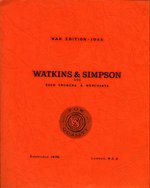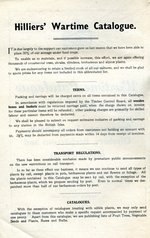“We again emphasize the necessity of extending our Home production of vegetables...The value of vitamins is greatest in those vegetables which are freshly gathered, and a constant supply of fresh vegetables in the choicest varieties of proved dietetic value is of inestimable value to the health of the Nation”
Carter’s Tested Seeds 1939 Garden and Lawn catalogue

Barr's Hardy Perennials, Rock Plants, Alpines, Climbers & Shrubs. Water Lilies and Hardy Aquatics. 1942.
The sacrifices made by British seed and nursery companies in the 1940s become poignantly apparent from reading their catalogues. In England, paper was rationed, so catalogues from 1940 on could only be of certain sizes; the paper is often cheaper, and the illustrations are either fewer or eliminated altogether. A note on the Barr & Son covers of this period said, “This catalogue has been reduced in size to economize paper. We regret that it has been necessary to omit all illustrations and reduce descriptions, etc. in many cases”. The W. Constable catalogue mentions how, “under the recent paper control order, in the future catalogues can only be sent in response to a written request”, and implores customers to “send…a postcard to this effect”. Bombs hit some company facilities, such as the London warehouse of Hurst & Son in 1941. Many gardeners--from company owners to laborers--became soldiers, resulting in labor shortages and the inability to supply certain crops. The wife of the proprietor of Fidler & Sons noted in its 1941 catalogue that her husband was “serving afloat”, and she was attempting to carry on the business as well as she could. The Watkins & Simpson catalogue of 1945 solicits donations for the Royal Gardeners’ Orphan Fund.
The war also cut off the exportation of European seeds to America. An article written at the National Agricultural Library in 1944 discusses how American farmers and gardeners wishing to locate varieties that they previously imported from Europe were using their seed and nursery trade catalogue collection as a resource.1 The result of the cessation of imports was a huge increase in vegetable and seed production in the United States, not only to provide for the domestic market, but also to feed our allies around the world. To help produce sufficient food and vegetable seed stock, flower growers such as Hillier’s had to convert land to vegetable production. William Macdonald described this situation in his wartime catalogues, remarking in 1945 that “flower novelties are as scarce as new cars— there has scarcely been any production since 1942!”



